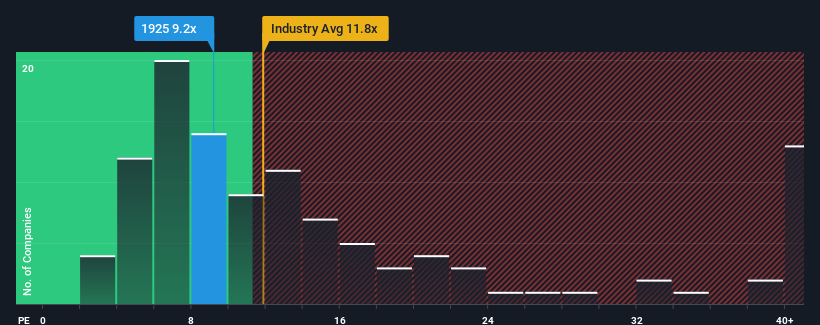- Japan
- /
- Real Estate
- /
- TSE:1925
Earnings Working Against Daiwa House Industry Co., Ltd.'s (TSE:1925) Share Price

With a price-to-earnings (or "P/E") ratio of 9.2x Daiwa House Industry Co., Ltd. (TSE:1925) may be sending bullish signals at the moment, given that almost half of all companies in Japan have P/E ratios greater than 15x and even P/E's higher than 23x are not unusual. However, the P/E might be low for a reason and it requires further investigation to determine if it's justified.
Daiwa House Industry could be doing better as its earnings have been going backwards lately while most other companies have been seeing positive earnings growth. It seems that many are expecting the dour earnings performance to persist, which has repressed the P/E. If you still like the company, you'd be hoping this isn't the case so that you could potentially pick up some stock while it's out of favour.
See our latest analysis for Daiwa House Industry

How Is Daiwa House Industry's Growth Trending?
There's an inherent assumption that a company should underperform the market for P/E ratios like Daiwa House Industry's to be considered reasonable.
Retrospectively, the last year delivered a frustrating 2.5% decrease to the company's bottom line. However, a few very strong years before that means that it was still able to grow EPS by an impressive 57% in total over the last three years. Accordingly, while they would have preferred to keep the run going, shareholders would probably welcome the medium-term rates of earnings growth.
Shifting to the future, estimates from the eight analysts covering the company suggest earnings should grow by 5.4% per annum over the next three years. That's shaping up to be materially lower than the 9.6% per annum growth forecast for the broader market.
In light of this, it's understandable that Daiwa House Industry's P/E sits below the majority of other companies. It seems most investors are expecting to see limited future growth and are only willing to pay a reduced amount for the stock.
The Final Word
We'd say the price-to-earnings ratio's power isn't primarily as a valuation instrument but rather to gauge current investor sentiment and future expectations.
As we suspected, our examination of Daiwa House Industry's analyst forecasts revealed that its inferior earnings outlook is contributing to its low P/E. Right now shareholders are accepting the low P/E as they concede future earnings probably won't provide any pleasant surprises. It's hard to see the share price rising strongly in the near future under these circumstances.
Having said that, be aware Daiwa House Industry is showing 2 warning signs in our investment analysis, and 1 of those can't be ignored.
If P/E ratios interest you, you may wish to see this free collection of other companies with strong earnings growth and low P/E ratios.
New: Manage All Your Stock Portfolios in One Place
We've created the ultimate portfolio companion for stock investors, and it's free.
• Connect an unlimited number of Portfolios and see your total in one currency
• Be alerted to new Warning Signs or Risks via email or mobile
• Track the Fair Value of your stocks
Have feedback on this article? Concerned about the content? Get in touch with us directly. Alternatively, email editorial-team (at) simplywallst.com.
This article by Simply Wall St is general in nature. We provide commentary based on historical data and analyst forecasts only using an unbiased methodology and our articles are not intended to be financial advice. It does not constitute a recommendation to buy or sell any stock, and does not take account of your objectives, or your financial situation. We aim to bring you long-term focused analysis driven by fundamental data. Note that our analysis may not factor in the latest price-sensitive company announcements or qualitative material. Simply Wall St has no position in any stocks mentioned.
About TSE:1925
Daiwa House Industry
Engages in the construction contracts business in Japan and internationally.
Fair value with mediocre balance sheet.
Similar Companies
Market Insights
Community Narratives



